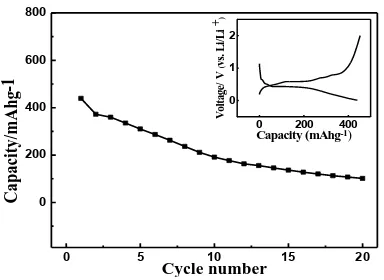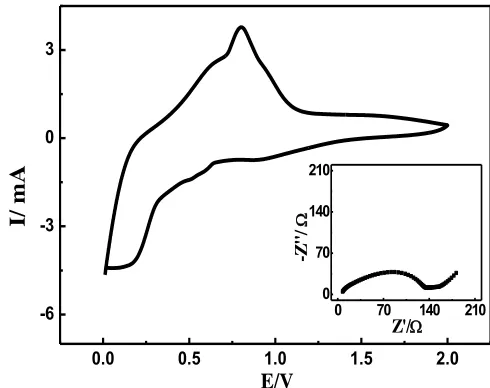Int. J. Electrochem. Sci., 13 (2018) 7718 – 7723, doi: 10.20964/2018.08.76
International Journal of
ELECTROCHEMICAL
SCIENCE
www.electrochemsci.orgShort Communication
Spine-shaped elementary Sn: Its Preparation and Application as
Anode Material for Lithium Ion Batteries (LIBs)
Hangchao Wang1, Xiaomi Shi2, Keqiang Ding1, 2,3*, Chenxue Li2, Yanzhi Sun1, Hui Wang3, Hongmin Dou3, Junqing Pan1*
1
State Key Laboratory of Chemical Resource Engineering, Beijing University of Chemical Technology, Beijing, 100029, P.R.China
2
College of Chemistry and Materials Science, Hebei Normal University, Shijiazhuang 050024, P.R. China
3
Hebei LingDian New Energy Technology Co., Ltd, Tangshan, Hebei, 064200, P.R.China To whom the correspondence should be made:
*
E-mail: dkeqiang@263.net, jqpan@mail.buct.edu.cn
Received: 14 February 2018 / Accepted: 4 April 2018 / Published: 5 July 2018
A novel finding, that spine-shaped elementary Sn can be prepared by using a constant voltage electrolysis method, was reported for the first time in this communication. The well-defined spine morphology of the prepared sample was evidenced by the SEM image, and the formation of elementary Sn particles with relatively higher crystallinity was documented by the obtained XRD pattern. More importantly, the galvanostatic charge-discharge measurement results indicated that the initial discharge capacity of the prepared sample was as high as 439 mAh g-1 at 100 mA g-1, and after 20 cycles, the discharge capacity could be maintained at about 101 mAh g-1 under the current density of 100 mA g-1. Showing the preparation of spine-shaped elementary Sn was the main contribution of this work, which was not only beneficial to the development of anode material of LIBs but also very favorable to the improvement of microelectronic devices.
Keywords: Electrodeposition, Spine-shaped Sn, X-ray techniques, nanoparticles , Lithium ion battery
1. INTRODUCTION
resources and environmental benignity [2]. However, the rapid capacity fading of Sn in operation, which was primarily resulted from the huge volume variation of Sn during cycling, was demonstrated to be the major reason limiting the further application of Sn in the commercial LIBs. Being composited with carbon [3] and creating nanostructured Sn particles [4] were thought as the main two ways to solve above problems. Also, as far as we know, the electrochemical performance of an electrode material was closely related to its morphology [5]. Thus, creating a special morphology was also a feasible way to promote the electrochemical performance of an anode material. For example, block shaped Sn particles with a size less than 100 nm, which were purchased from Aladdin, were used as anode materials for LIBs in Yang’s work [6]. Piao’s group [7] developed a novel kind of anode material for LIBs, namely, Sn/SnOx-loaded uniform-sized hollow carbon spheres on graphene
nanosheets. And in their works, the resultant agglomerated Sn particles had a size of 100-300 nm. Yin [8] designed a novel three-dimensional porous Sn@PVP-CX composite for LIBs, in which the spherical Sn nanoparticles (NPs) were prepared via a chemical reaction using SnCl2 and NaBH4 as the
starting materials. Elementary Sn nanoparticles can also be fabricated using an electrochemical method. For example, the galvanostatic electrodeposition of irregular Sn particles was successfully achieved by Han’s group in 2008 [9], and in their works, the electroplating solution contained SnCl2
and citrate. Also, the synthesis of non-regular Sn particles with a dendritic growth was accomplished by Anicai’s group [10] by using a constant current method. To the best of our knowledge, the preparation of spine-shaped Sn particles using a constant voltage electrolysis method has not been reported so far, not to speak of using spine-shaped Sn particles as anode materials for LIBs.
2. EXPERIMENTAL
2.1 Electrochemcial preparation of the spine-shaped Sn particles
The synthesis of the spine-shaped elementary tin (Sn) was conducted by a very simple method of constant-potential electrolysis. Briefly, two Sn foils with an identical size of 80×30×0.5mm as the electrodes were placed in a 0.5M glacial acetic acid contained beaker. And then the two electrodes were respectively connected with the anode and cathode of a DC stable power supply (WYJ series, Shanghai Querli Electrical Equipment Co., Ltd.). And then the decomposition voltage was controlled at 10 V for 15 min. Subsequently, the cathode was took out and carefully washed by distilled water for several times. Finally, the scraped coatings of the cathode were collected and heated at 80 °C in a drying oven for 30 min, after a thorough 20 min milling, the spine-shaped elementary Sn particles were prepared. Emphatically, no Sn salt was contained in the electroplating solution of 0.5M glacial acetic acid, which was another novelty of this work.
2.2 Electrochemical measurements
employed as both the auxiliary and reference electrodes. The galvanostatic charge-discharge measurements were conducted on an equipment of CT-3008W-5V20mA-S4 (Shenzhen Neware Electronics Co., Ltd. China). In above experiment, the starting voltage and the cut-off voltage were respectively 0.01V and 2 V.
[image:3.596.207.388.207.349.2]3. RESULTS AND DISCUSSION
Figure 1. SEM image for the prepared sample. The inset was the XRD pattern of the resultant sample.
The morphology of the resultant sample was examined by SEM and given in Fig.1. Apparently, the length of the so-called spine was about 50 μm, and the length of intertransverse bone ranged from 0.8 μm to 5 μm. Also, it was evident that the huge spine was constructed by many small single crystals. To the best of our knowledge, this is the first time to report the preparation of spine shaped elementary Sn particles, though Sn particles with spherical morphology [8] or irregular shape [9] have been successfully produced in the previous works. This particular shape of Sn particles was probably helpful to the development of microelectronic devices [15] and microcircuit [16], to our knowledge.
0 5 10 15 20
0 200 400 600 800
0 200 400 0
1 2
Capacity (mAhg-1)
V
ol
ta
ge
/
V
(
vs
. L
i/
L
i
+)
Cap
acit
y/mAh
g-1
Cycle number
[image:3.596.202.394.568.708.2]
The XRD pattern of the prepared sample, as well as the standard XRD pattern for elementary Sn, is illustrated by the inset of Fig.1. The presence of higher diffraction peaks indicated the better crystallinity of the prepared sample. The diffraction peaks, which were positioned at about 30.6º, 32.2º, 44.1º, 45.0º, 55.5º and 62.7º, corresponding to the crystal facets of (200), (101), (220), (211), (301) and (112), respectively, are the main characteristic reflections of face centered cubic crystalline elementary Sn (JCPDS No. 04-0673) [12]. The XRD patterns of other impurities like SnO2 [13] and SnO [14]
were not displayed in Fig.1 which indicated that the prepared sample was pure elementary Sn.
The initial charge-discharge profile of the sample is given by the inset of Fig.2. Clearly, a relatively stable discharge voltage plateau was observed at about 0.42V, which was accompanied by a charge voltage plateau of at around 0.6V. In the previous work of using Sn as anode for LIB [6], no flat charge and discharge voltage plateaus were displayed. Generally, the presence of the flat charge or discharge voltage plateaus usually indicated a pure two phase transition in the charge or discharge process [5]. Thus, it can be concluded that the purity of the prepared spine-shaped Sn particles was higher as compared to the previously prepared Sn. The initial charge and discharge capacities of the prepared sample were 453 and 440 mAh g-1, respectively. It strongly indicated that the charge-discharge process of the sample was not a reversible process, which was detrimental to the cycling performance of a Li ion battery. Although the discharge capacity of Sn anode reported here was smaller as compared to the published work [6], the spine-shaped elementary Sn particles were really presented in this work for the first time.
The cycling performance of the prepared samples was also evaluated and illustrated in Fig.2. Evidently, the discharge capacity decreased obviously with increasing the cycle number. For instance, after 20 cycles, the discharge capacity decreased from 440 mAh g-1 to 101 mAh g-1 at the current density of 100 mA g-1. This result strongly demonstrated that the prepared spine-shaped elementary Sn could be employed as anode material for LIBs, though a smaller discharge capacity was delivered by the resultant sample.
0.0 0.5 1.0 1.5 2.0
-6 -3 0 3
0 70 140 210
0 70 140 210
-Z
''
/
Z'/
E/V
I/
m
[image:4.596.171.416.512.706.2]A
To further investigate the delithiation/lithiation process in the synthesized sample, the cyclic voltammograms (CVs) of the half-cell were recorded and shown in Fig.3. In the anodic potential scanning, an oxidation peak centered at about 0.8V was displayed, which was generally originated from the delithiation process [5]. While, in the negative potential scanning, three small reduction peaks of at 0.17V, 0.52V and 0.90V were respectively displayed which were commonly from the lithiation process in the produced sample. This result strongly indicated that the delithiation/ lithiation process, namely, xLi+Sn-xe↔LixSn [6], was not a reversible process, being well consistent with the results
shown in Fig.2. The Nyquist plot of the half-cell was also recorded and illustrated by the inset of Fig.3. Evidently, the shape of this Nyquist plot was very similar to our previous work concerning the Nyqusit plot of a lithium half-cell [17]. Among all the parameters derived from the Nyquist plot, the value of Rct was the most widely used parameter through which the kinetics of the charge-discharge process
could be compared directly. Generally, a smaller value of Rct corresponded to a faster kinetics of the
charge-discharge process. The value of Rct here was close to 140 Ω which was close to that of initial
Nyquist plot for the Sn/CNT/PVDF [6].
4. CONCLUSIONS
For the first time, spine-shaped elementary Sn was prepared by a constant voltage electrolysis method, in which no Sn-based salt was contained in the electroplating solution. Also, it was documented for the first time that the spine-shaped elementary Sn could be employed as anode material for LIBs though the discharge capacity of the prepared sample was not superior to that of the currently reported Sn-based anode material. This novel finding was believed to be very beneficial for both the development of anode materials for LIBs and the exploration of microelectronic devices or the microcircuit.
ACKNOWLEDGEMENTS
This work was supported by National Natural Science Foundation of China (21676022 & 21706004) and the State Key Program of National Natural Science of China (21236003), and the Fundamental Research Funds for the Central Universities (BHYC1701A & JD1701).This work was also financially supported by the Natural Science Foundation of Hebei Province of China (No. B2015205150).
References
1. X. Lu, L. Gu, Y.-S. Hu, et al., J. Am. Chem. Soc. 137 (2015)1581-1586. 2. J. Yang, M. Winter, J. O. Besenhard, Solid State Ionics 90 (1996) 281-287. 3. Y. Yu, L. Gu, C.Wang, et al., Angew. Chem. Int. Ed. 48 (2009) 6485-6489. 4. Z. Zhu, S. Wang, J. Du, et al., Nano Lett. 14 (2014) 153-157.
5. K. Ding, H. Gu, C. Zheng, et al., Electrochim. Acta 146 (2014) 585-590.
6. Y. Zhao, L. Yang, D. Liu, et al., ACS Appl. Mater. Interfaces 10 (2018) 1672-1677. 7. J. Lee, T. Hwang, J. Oh, et al., J. Alloys Compd. 736 (2018) 42-50.
9. C. Han, Q. Liu, D. G. Ivey, Electrochim. Acta 53 (2008) 8332-8340.
10.L. Anicai, A. Petica , S. Costovici, et al., Electrochim. Acta 114 (2013) 868-877. 11.K. Ding, J. Zhao, J. Zhou, et al., Mater. Chem. Phys. 177 (2016) 31-39.
12.Y. Cheng, Z. Yi, C. Wang, et al., Chem. Eng. J. 330 (2017) 1035-1043. 13.S. Shi, T. Deng, M. Zhang, et al., Electrochim. Acta 246 (2017) 1104-1111. 14.S. Wang, W. Zhao, Y. Wang, et al., Electrochim. Acta 109 (2013) 46-51. 15.M. Gamella, A. Koushanpour, E. Katz , Bioelectrochemistry 119 (2018) 33-42. 16.Y. Zhang, L. Guo, S. Wei, et al., Nano Today 5 (2010) 15-20.
17.K. Ding, J. Zhao, Y. Sun, et al., Ceram. Int. 42 (2016) 19187-19194

